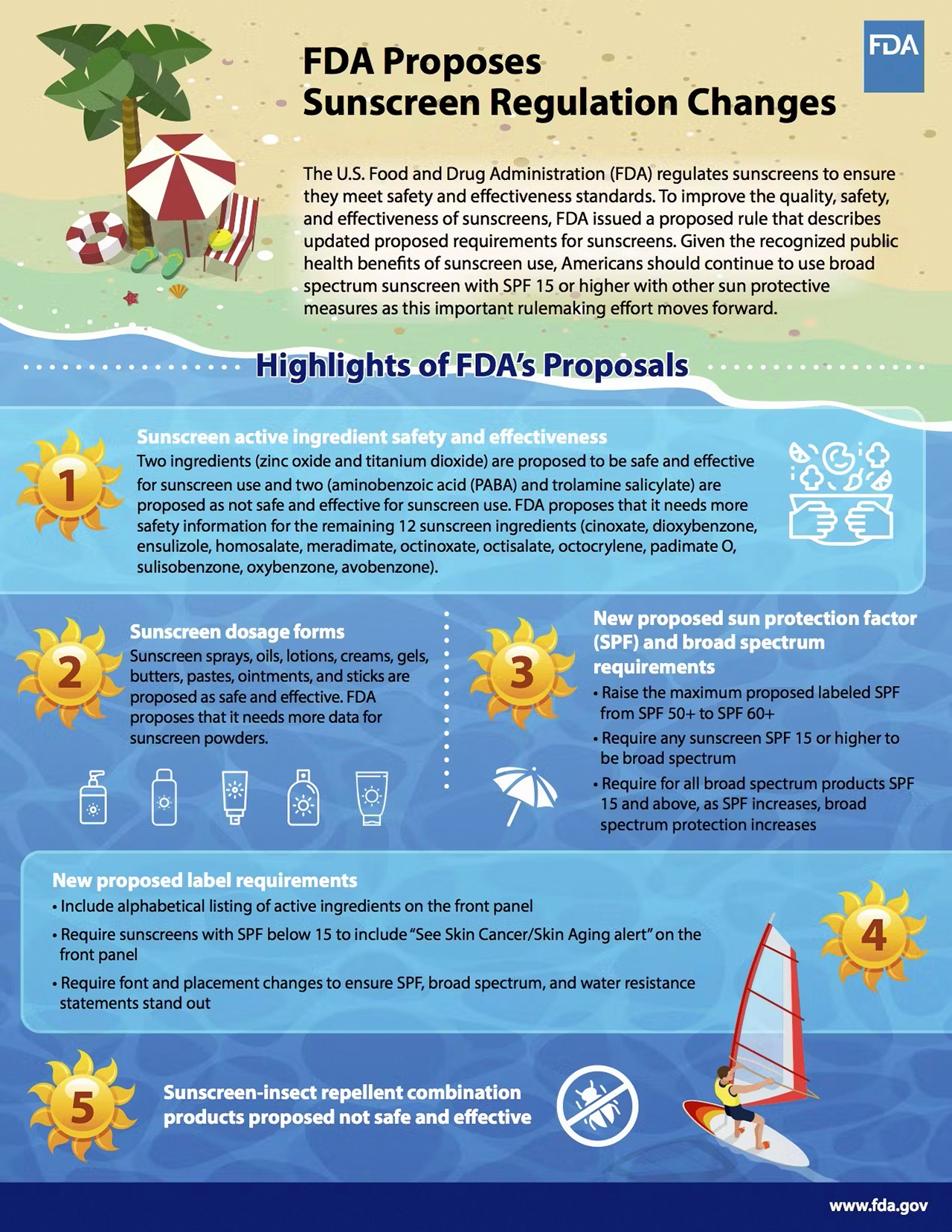Mary Warner

Although sun exposure has been known to have damaging effects on skin since ancient times when Egyptians used mixtures thought to prevent sunburn, it wasn’t until the late 1800s that the negative health effects of prolonged exposure to UV rays were scientifically confirmed. In 1896, Paul Unna, a German physician, described an association between sun exposure and skin cancer, and in 1910, Unna developed a sunscreen from chestnut extract. Until the 1980s, however, sunscreen use wasn’t common, and the first sun protection factor (SPF) 15 sunscreen wasn’t introduced until 1986. In recent years, as cases of skin cancer have increased, the safety and effectiveness of sunscreens has garnered much attention.
FDA’s role
FDA has regulated sunscreens since the 1970s and has regularly issued guidance about ingredients and dosage. In 2019, FDA issued a new proposed rule on sunscreens, which suggested revisions to the requirements for sunscreen active ingredients; maximum SPF levels; broad spectrum requirements (protection against both UVA and UVB rays); and dosage forms, among other things. The proposed rule also included updates on how sunscreens are labeled to make it easier for consumers to identify key information.
In 2020, before the 2019 rule took effect, the CARES Act replaced the rulemaking process with an administrative order process for issuing, revising, and amending OTC monographs, which establish conditions, such as active ingredients, uses (indications), doses, labeling, and testing, under which an OTC drug is “generally recognized as safe and effective” and can be marketed without a new drug application and FDA pre-market approval. The new process allows for revision of monographs as new data become available or emerging safety issues arise.
In September 2021, FDA issued a proposed order that transitions several of the proposals in the 2019 regulation, including those pertaining to safe and effective ingredients, dosage forms, SPF and broad-spectrum coverage requirements, labeling requirements, and combination sunscreen/insecticide products to the new order process created by the CARES Act (see infographic, below).

Understanding sunscreens
Sunscreen comes in many forms, including lotions, creams, sticks, gels, oils, pastes, and sprays. It’s important to note that the safe and effective status for spray sunscreens is subject to testing and labeling requirements in the 2021 proposal and that sunscreen sprays should never be applied directly to the face. FDA has not authorized marketing of nonprescription sunscreen products in the form of wipes, towelettes, powders, body washes, or shampoos.
The SPF value of a sunscreen indicates the level of sunburn protection provided, with higher SPF values providing greater sunburn protection. However, because SPF values are determined using a test that measures protection from only UVB radiation, these values only indicate a sunscreen’s UVB protection. Beginning in 2011, sunscreens that demonstrate protection against both UVA and UVB radiation can be labeled as “Broad Spectrum SPF [value].”
It’s important to choose a suncreen with broad spectrum protection from both UVA and UVB radiation and one with an SPF of at least 15. Sunscreens that are not broad spectrum or that lack an SPF of at least 15 must carry a warning on the label stating that it has been shown only to help prevent sunburn, not skin cancer or early skin aging.
Two ingredients (zinc oxide and titanium dioxide) are considered to be safe and effective in the 2021 proposed order. Sunscreens that contain the two ingredients (PABA and trolamine salicylate) that are proposed as not safe and effective for sunscreen use and the 12 ingredients for which FDA needs more safety information are still available but should be used with caution.
It’s also important to note that in Europe and other areas beyond the United States, sunscreens are regulated as cosmetics rather than as drugs and are subject to different marketing requirements. If a sunscreen is purchased outside the United States, it’s important to read the label to understand the instructions for use and any potential differences between it and U.S. products.
Finally, FDA notes that there is no such thing as waterproof sunscreen. Products labeled as “water resistant” must state whether they remain effective for 40 minutes or 80 minutes after swimming or sweating, and all sunscreens must provide clear instructions on when they should be reapplied.
What to tell your patients
Advise patients to choose a sunscreen with an SPF of at least 15, and for those with fair skin, an SPF of 30 to 50 is recommended. Because the SPF is related to the intensity of sun exposure, not the time of exposure, patients should consider time of day as well as geographic location (solar intensity is highest in mid-day and at lower latitudes) when using sunscreen. Time in the sun should be limited between 10 am and 2 pm, with sunscreen applied at least every two hours. Sunscreen should also be used regardless of temperature as harmful UV rays are out year round. Because sunscreens are not recommended for infants under 6 months, these youngest patients should be covered when in the sun. ■